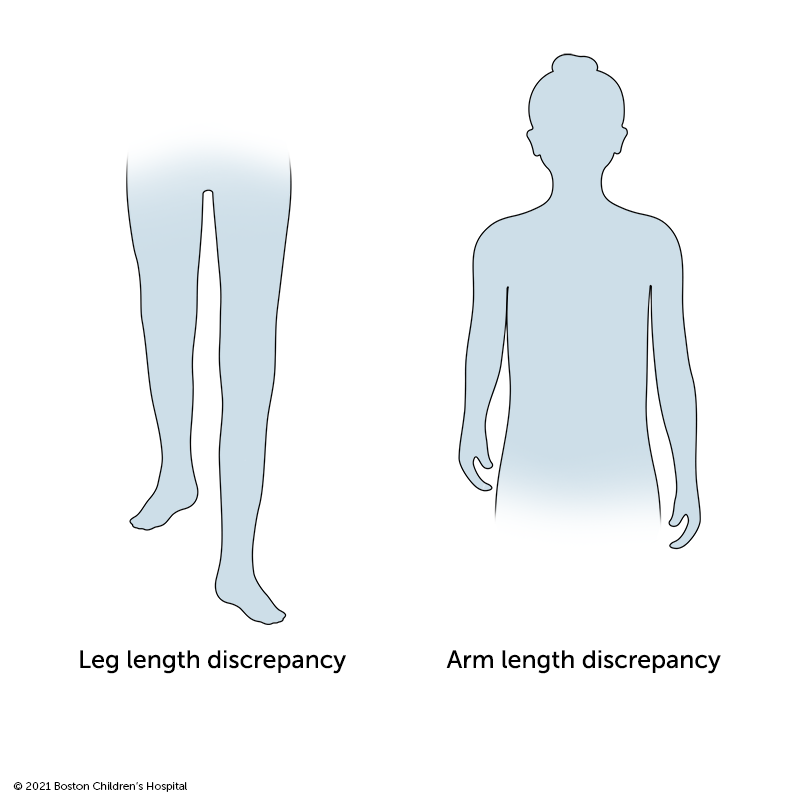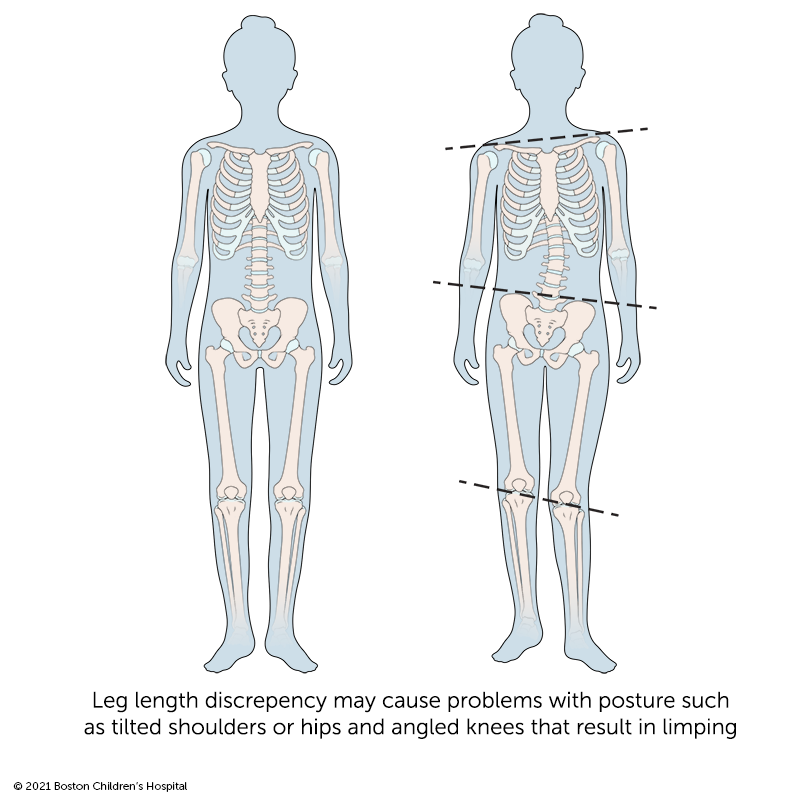Limb Length Discrepancy | Diagnosis & Treatments
How is a limb-length discrepancy diagnosed?
The first step in diagnosing a limb-length discrepancy is a complete medical history and physical examination by an orthopedic surgeon. During the exam, the doctor will measure your child's limbs to calculate how different they are in length.
If your child has a leg-length discrepancy, the doctor may watch your child walk to look for signs that they are compensating for their different leg lengths. Their doctor may also ask your child to stand with a block under their shorter leg to measure the amount of correction needed to bring their hips and the rest of their body into alignment.
Your child’s doctor may also order an x-ray or other imaging tests for a more precise measurement of the discrepancy.

Limb-lengthening surgery: A look at the pros and cons
The procedure can save a patient’s leg or arm. However, it often requires multiple surgeries and carries inherent risks.
How are limb-length discrepancies treated?
Limb-length discrepancies can be treated in several different ways. Some treatments involve surgery while others don’t. Your child’s orthopedic surgeon will talk with you about the options for your child based on:
- your child's age, overall health, and medical history
- the limbs affected (leg or arm)
- the amount of discrepancy
- your child's tolerance for specific medications, procedures, or therapies
- your and your child’s expectations and preferences
Some treatments to equalize limb length are simple and safe. Others, especially limb-lengthening surgery, are complex and carry a risk for complications.
Non-surgical treatments for leg-length discrepancy
Several non-surgical treatments may help improve function, especially if your child has a mild length discrepancy (less than one inch for a leg; less than two inches for an arm).
- A shoe lift inside the shoe of your child’s shorter leg can level out the difference in leg lengths. A shoe lift may help your child walk and run with greater ease and reduce back pain.
- Physical therapy includes special stretches and exercises that can help reduce pain and increase overall function.
- Occupational therapy focuses on developing your child’s fine motor skills, such as handwriting.
- Adaptive devices can help your child with everyday activities, such as tying their shoes, buttoning their shirt, and holding a book.
- Prosthetics can be designed to fit over a short limb. They can also replace all or part of a limb that has been amputated.
Surgical treatments for limb-length discrepancy
Leg-shortening surgery
If your child’s leg-length discrepancy is expected to be moderate (between two and six centimeters) when your child reaches adult height, their surgeon may recommend shortening the longer leg. Shortening procedures slow growth of the longer leg so the shorter leg can catch up. This is generally safer and results in fewer complications than limb-lengthening surgery. Your child will be slightly shorter at adult height than they would be without leg-shortening surgery.
- Epiphysiodesis is performed on children who are not yet done growing. The surgeon fuses the growth plate, either temporarily or permanently, to prevent growth in the longer limb. Timing is important in order to avoid over- or under-correction of the leg’s length.
- Epiphyseal stapling uses staples that are surgically inserted on each side of the growth plate. Once the legs are of equal length, the staples are removed.
- Bone resection involves removing a section of bone in the longer leg. This can be performed on adults or adolescents who have reached their adult height.
Limb-lengthening surgery
Limb-lengthening surgery stimulates new bone growth in the shorter leg or arm. Limb lengthening is performed only on patients with significant limb-length discrepancies that interfere with activities of daily life. It is typically performed when patients are in their late teens or early adulthood.
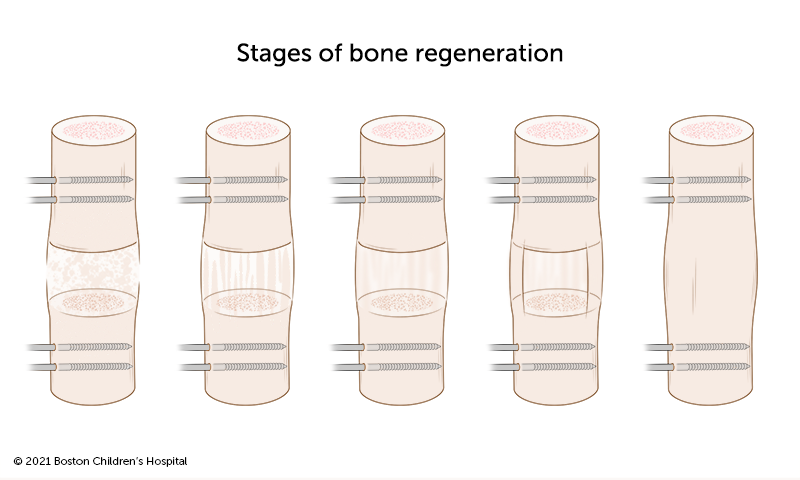
Lengthening surgeries take several months and may need to be repeated, depending on your child’s stage of growth and the extent of their limb-length difference.
- In the first stage of limb lengthening, an orthopedic surgeon cuts the bone to be lengthened (a procedure called an osteotomy). They then attach a lengthening device that your child will wear for several months. The types of lengthening devices are described in greater detail below.
- Over the next several months, you or your child will adjust the device every day to increase the gap between the two ends of bone. This will stimulate the body’s natural healing process to create new bone to fill in the space.
- While the lengthening is taking place, your child will need to have regular visits with their orthopedic surgeon to ensure the lengthening is going smoothly and address any possible complications before they become serious.
Types of limb-lengthening devices
There are two types of limb-lengthening devices. One type is worn on the outside of the arm or leg. The other is an internal device that is more precise and reduces the risk of complications and infection.
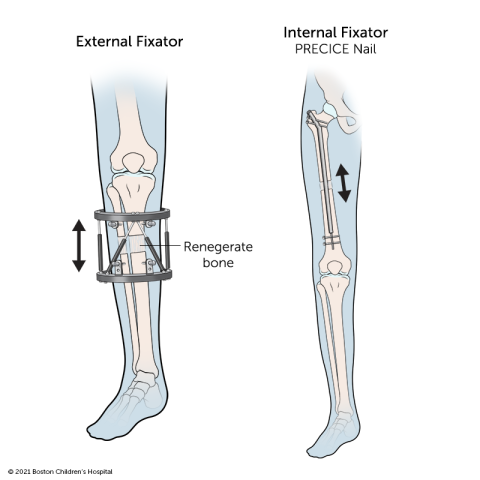
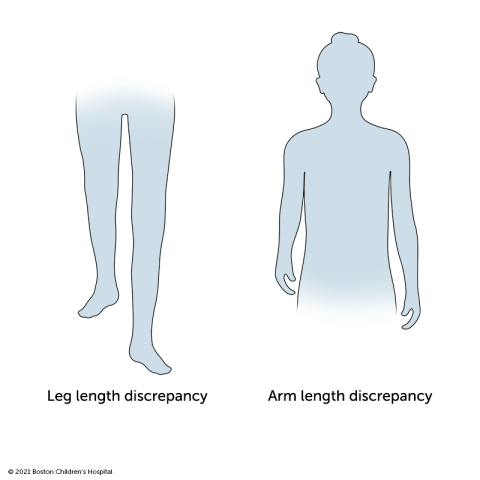
External fixators are worn on the outside of the limb and are attached to the bone by pins. The patient or family adjusts the device daily to increase the distance between the two ends of bone. Once the correct length is reached, the device remains on the leg or arm while the new bone hardens and becomes strong. The device is then surgically removed.
The internal fixator (PRECICE Nail) is a nail that is surgically inserted inside the bone after the osteotomy. Using an external magnet that causes the nail to expand, the patient or family slowly lengthens the bone a tiny amount each day until the desired length is reached. Like the external fixator, the internal fixator is removed once the limb has been lengthened and new bone has formed.

Left humerus: A. prior to lengthening; B. one year after initial lengthening of ~4.5 cm using a PRECICE nail; C. immediately after second lengthening of ~4.5 cm; D. six months after second lengthening.
How we care for limb-length discrepancies
The Limb-Lengthening and Reconstruction Program at Boston Children’s Hospital provides comprehensive care for children and young adults with leg or arm differences that are present at birth or caused by injury or illness. Our team, which draws on experts from both our Lower Extremity Program and Hand and Orthopedic Upper Extremity Program, has deep expertise in both non-surgical care and limb-lengthening and reconstruction procedures.
Our clinicians have treated thousands of babies, children, and young adults with conditions that range from routine to highly complex limb differences. We also offer the benefits of the extensive services available at Boston Children’s, as well as some of the most advanced clinical and scientific research in the world.
We’ll work with you and your child to review the available options and decide the best course of treatment based on your child’s individual needs.

